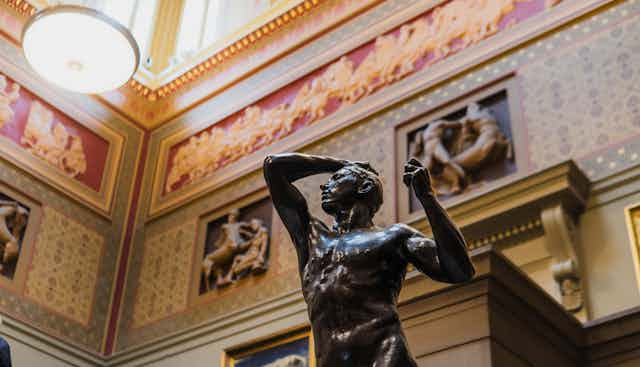Amid a flurry of manifesto promises over the past week, the UK’s two main parties have both made various pledges to invest in arts and culture. Labour has promised to invest in a £1 billion Cultural Capital Fund to transform institutions in towns that have been “neglected for too long”. Meanwhile the Conservatives have pledged to fund an “arts premium” in secondary schools and offer business rates relief for music venues and cinemas.
It’s fair to say that Labour’s promise has grabbed the headlines more than that of the Conservatives. Their so-called Charter for the Arts has also won the PR war, garnering the support of hundreds of artists, including celebrities such as Maxine Peake, Lily Allen and Ken Loach.
The Conservatives perceive the arts as “nice to have”, the peripheral tinsel on the tree of learning. This is despite growing evidence from the likes of the Cultural Learning Alliance and the recent Durham Commission that effective arts education can foster creativity, innovation, empathy and resilience. It can also make children happier and healthier. Labour also backs a £160 million annual “arts pupil premium”, designed to fund arts education for every primary school child and ensure that arts and creativity are embedded in the curriculum.
It’s interesting to note that alongside schools, both main parties have placed local libraries and museums at the heart of their cultural policies. Before releasing their manifesto, the Conservatives had already announced a £250 million Culture Investment Fund to support Coventry and the UK City of Culture programme, York’s National Railway Museum, the Cultural Development Fund, and upgrades to museums and libraries.
Read more: Arts education helps school students learn and socialise. We must invest in it
Renewed pledges to favourites
Alongside its own Cultural Capital Fund, Labour is also committing to a UK City of Culture programme, championed recently by both Tom Watson and Yvette Cooper. Supporters of this policy cite the apparent successes of Derry/Londonderry in 2013 and Hull in 2017 as UK Cities of Culture. Detractors, however, critique the flawed economic impact methods used to justify such investment and the potentially damaging nature of what could be considered a costly urban beauty contest.

In what appears to be an excellent week for the UK’s museums, both main parties have pledged to maintain support for free entry to national museums. This remains a controversial issue, which divides both cultural practitioners and academics.
Read more: How Hull went from crap town to City of Culture – and what it says about Brexit Britain
Perhaps counter-intuitively, there is no solid evidence that free entry has shifted the demographics of museum and gallery audiences. There is, however, a compelling argument to introduce either a “pay-what-you-decide” system and/or an entry charge for international visitors.
Labour’s promise to redistribute National Lottery funding to more closely reflect ticket sales is much more likely to address the age-old problem of regressive taxation of the arts. It has justifiably won favour amongst supporters of cultural democracy – not least because it comes with a pledge for a more participatory approach to how Lottery awards should be spent.
Both parties’ ongoing commitment to the creative sector tax relief introduced in 2016 by the former chancellor George Osborne is welcome. It has already boosted cultural production and offered a lifeline to the small and micro organisations that are often the real creative pioneers. But this will in no way compensate for the estimated £40 million per annum in EU funding the arts and cultural sector is expected to lose after Brexit, compounded by the additional costs that will be incurred to overcome new restrictions on the free movement of artists, both in and out of the UK.
Flawed logic
While many in the arts and cultural sector have welcomed Labour’s manifesto arts offerings, others have noted that the ambitious pledge to increase the proportion of GDP the government spends on arts from 0.3% to meet the European average of 0.5% in the last manifesto has disappeared.
Numerous reports demonstrate the UK’s competitive and artistic edge in the cultural and creative industries and their impressive growth rate – even in times of recession and austerity. Between 2010 and 2017, GVA (the gross value added) of the creative industries increased by 53.1% and contributes around £23bn to GDP.
So regardless of political ideology, it would seem strategic to introduce a competitive level of mandated investment in the country’s fastest-growing industry and to guarantee its long-term sustainability.
Ultimately, Labour’s manifesto commitments are dazzling but flawed. While ambitious, they’re less generous than the promises made in 2017 and based on some unsound logic. However, they do represent a step in the right direction. They also demonstrate a continuing acknowledgement of the vital role that arts and culture play in citizens’ education and general wellbeing, alongside the positive impacts they can have on our towns and cities.
While it is heartening to see both major parties champion the cultural sector and its socioeconomic impacts, in comparison to Labour’s pledges, the Conservative manifesto offers little new investment and lots of spin. Considered in the context of a pending Brexit that will cost the sector millions, neither party’s pledges offer much hope to organisations that actually produce art. Unless the swingeing cuts to local authorities are reversed these organisations are likely to be squeezed quite hard from both ends.


